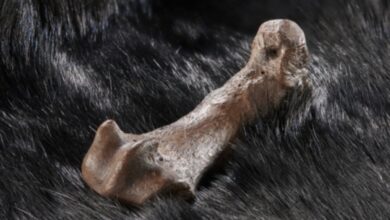New dinosaur species may be closest known relative of T. rex, study suggests

A new dinosaur species may be the closest known relative of Tyrannosaurus rex, a new study suggests.
The research reshapes scientists’ understanding of how the most famous dinosaur – T. rex – might have first arrived in North America, by introducing its earliest known relative on the continent.
Researchers have identified the newly discovered subspecies of tyrannosaur known as Tyrannosaurus mcraeensis.
The predator is older and more primitive than its better-known cousin, but just as big – roughly the size of a double-decker bus.
The findings are based on a partial skull collected years ago from western New Mexico and on display at the New Mexico Museum of Natural History and Science (NMMNHS).
It shows that tyrannosaurus was in North America millions of years before palaeontologists previously thought.
Based on the location of other fossil finds that have previously been dated to between 66 and 75 million years ago, the researchers suggest T. mcraeensis may have lived between 71 and 73 million years ago – some five to seven million years before T. rex.
T. rex is so well-known, so it became possible to show the New Mexico tyrannosaur was something new.
Dr Nick Longrich, a co-author from the Milner Centre for Evolution at the University of Bath, said: “The differences are subtle, but that’s typically the case in closely related species.
“Evolution slowly causes mutations to build up over millions of years, causing species to look subtly different over time.”
When then-student Sebastian Dalman began a restudy of a horned dinosaur, it forced a broader rethink of the dinosaurs from western New Mexico.
“I started working on this project in 2013 with co-author Steve Jasinski and soon we started to suspect we were onto something new,” he said.
A team of scientists from New Mexico, elsewhere in the USA, Canada, and Bath, in the UK, was assembled to study the animal, going through the skeleton bone by bone.
They all found subtle differences in the shape of, and joins between, the skull bones of the specimen and the dozens of T. rex skeletons previously found.
The newly discovered dinosaur was roughly the same size as a T. rex, which measured up to 40 feet (12 metres) long and 12 feet (3.6 metres) high, and it also ate meat.
While the new discovery predates T. rex, subtle differences in the jaw bones make it unlikely it was a direct ancestor, the researchers said.
Experts suggest this raises the possibility there are still more new tyrannosaur discoveries to be made.
Dr Spencer Lucas, paleontology curator at NMMNHS, said: “Once again, the extent and scientific importance of New Mexico’s dinosaur fossils becomes clear – many new dinosaurs remain to be discovered in the state, both in the rocks and in museum drawers.”
According to the researchers, the new discovery expands our understanding of tyrannosaurs.





